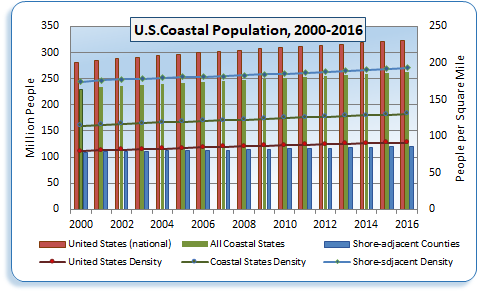 Population and Housing data are important parts of ocean and
coastal economic picture. Like employment, wages and GDP, the growth
or decline in population and housing is an essential measure of economic
health.
Population and Housing data are important parts of ocean and
coastal economic picture. Like employment, wages and GDP, the growth
or decline in population and housing is an essential measure of economic
health.
The vast majority of the nation's population and growth is found along
the coasts of the oceans and Great Lakes:
- 81.4% of the population lives in coastal states on 57% of the
nation's land area.
- 37.4% of the population can be found in counties adjacent to the
oceans and Great Lakes. These counties occupy less than 18% of the
land.
- Population densities continue to grow highest in coastal states
where dependence on ocean resources are greatest. The coastal states
population density in 2016 was about 130 per sq. mile while
non-coastal states average density was 39. Shoreline counties had about 193
people per sq. mile; however the nearby non-adjacent Coastal Zone
counties had a population density of over 306, an increase of 52.7 people
per sq. mile and a growth rate of 20.8% since 2000.
- Overall U.S. population growth for the 16 year, 2000-2016 period was 41.7
million people. 79.3% of the growth occurred in the coastal states and
29% in shore-adjacent counties.
The growth and density of U.S. housing units is similar to those of the population:
- Of the 135.7 million U.S. housing units in 2016, 81% were in the
coastal states.
- The overall density of U.S. housing units was 38.4 per sq. mile. For coastal
states, the density was 54.3, compared with a housing density of only 17.2
for non-coastal states. While the shore adjacent counties show a high
density of 82.1 per sq. mile, it is the nearby non-adjacent coastal
counties that hold the highest density of 123.2.
- Of the 19.8 million U.S. housing units added between 2000 and 2016, 79.1%
were in coastal states and 30.3% were in shoreline adjacent counties.



